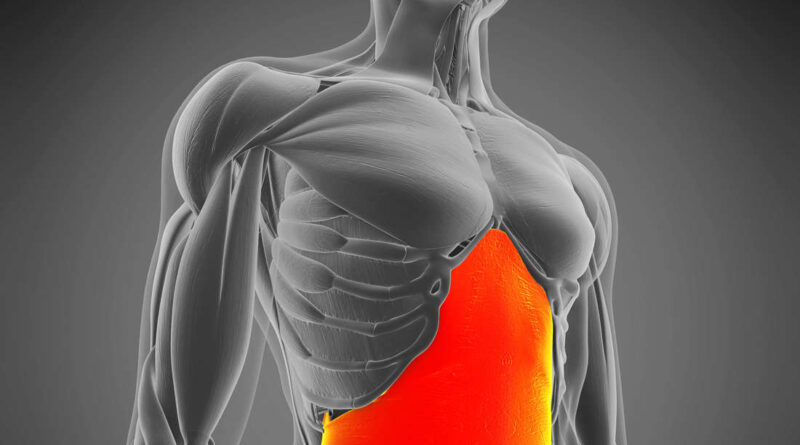A little-noticed muscle that forms a thin stomach

The Transversus Abdominis muscle is often overlooked when it comes to strengthening the abdominal muscles, but it is important for a small stomach. Here you will learn more about its structure, function and how to train the deep abdominal muscles.
The desire for a flat stomach is widespread, but many people focus only on the upper abdominal muscles, such as the rectus abdominis, which are responsible for developing the classic six pack. The transversus abdominis muscle (Musculus transversus abdominis) is often overlooked, but it plays an important role in body function. This deep muscle runs up and around the torso and acts like a natural corset. In terms of appearance, a strong transversus ensures a flat stomach. Below, fitness expert Alexandra Grauvogl explains more about the structure and process of muscle training.
Anatomy and function of the transversus abdominis
In addition to the oblique abdominal muscles (M. obliquus externuns abdominis and M. obliquus internus abdominis), the transversus abdominis muscle is one of the back abdominal muscles. Unlike the rectus abdominis and obliques, the transversus cannot be seen because it lies underneath. It divides the space between the chest and the pelvis and closes the torso upwards:
- Origin: inner surface 7th-12th century Costal cartilage, lumbar ligament
- Insertion: internal tendon plate, white line (Linea alba)
Its main functions include abdominal pressure and thus stabilization of the lumbar spine (for example, when lifting heavy loads). As a secondary function, the transversus abdominins muscle is responsible for increasing intra-abdominal pressure (for example, emptying the bladder and intestines or pushing during childbirth) and supporting the airway.
The outward signs of a weak transversus abdominis muscle are tight abdominal muscles above the navel but a bulge below. Even highly trained people with six-pack abs can have this wave.
Health Benefits of a Strong Transversus Muscle
A strong transversus abdominis muscle provides not only aesthetic benefits like a slim waist, but also health benefits. Studies show that it can relieve back pain.
A well-trained transversus also protects against injuries by stabilizing the spine. This is especially important for heavy exercises like squats and deadlifts. According to a study, anyone who engages his abdominal muscles specifically before core training improves.
Trainingshinweis: “Especially when you do weight training with heavy weight – for example, deadlifts or squats – the back needs to be very stable. The back extensors often cannot do This alone and strength athletes use the abdominal press. The weight lifting belt supports and protects the transversus abdominis muscles when doing abdominal presses because it sits like a ring. is tight around the abdomen and increases the pressure in. However, you should not always work with a weight belt, otherwise the transversus abdominis muscles will not be compressed enough and it will lose strength. Tip: For example, do warm-up squats or dead squats with a light weight without a belt to activate the abdominal muscles, Alexandra Grauvogl, fitness trainer
Das method of abdominal drawing
The Abdominal Drawing-In Maneuver (ADIM) is a basic exercise to activate the transversus abdominis muscle. Christine Lynders describes this process in her study as follows:
- Lie on your back, knees bent at 90 degrees, feet flat on the floor, arms close to your body.
- Pull your belly button toward your back.
- Maintain tension while continuing to breathe normally.
Do not strain or stretch the lower abdominal muscles. When your abdominal muscles contract, your stomach moves slightly inward, not outward. Do not flatten your back, tighten your ribs, or press your lower back into the water, as this works the upper abdominal muscles.
If you want to practice ADIM while standing, place your left hand directly under the breastbone and your right hand under the belly button. When the transversus abdominis muscles work properly, the lower arm goes in while the upper arm remains the same.
Train the transversus abdominis muscle: 2 active exercises
If you want to strengthen your abdominal muscles, planks and squats are an easy way to do this using your own body weight. When doing both isometric exercises, you should make sure to pull your belly button toward your back, directly engaging the transversus abdominis muscle.
1. Holding the Pit
- Lie on your back, tighten your abdominal muscles and your whole body
- Raise your extended arms and legs off the floor, about 20 cm up
- Hold the position

Download our free training plan for beginners HERE.
2. Wood
- While lying on your stomach, support yourself with your forehead, elbows under your shoulders.
- First hands facing forward. Look down/forward, don’t overextend your neck.
- Lift your upper body, hips and knees off the floor and squeeze your entire body and buttocks. Keep your body straight from head to toe.

Are you famous? How long should it take you to be able to do a plank
This exercise strengthens the transversus abdominis muscles and improves core stability. It is an important part of a balanced training program for a flat stomach and a strong back. Anyone who trains Transversus only for apparent reasons – it would be a shame – should remember that a flat stomach always needs a proper, balanced and healthy diet, in order to keep the fat part of the ‘ bodies within limits. Even the transversus abdominis muscles cannot remove the “swim ringage”.
Abdominal muscles play only a small role in getting a six pack. In the middle of the abdominal muscles visible is the rectus abdominis muscle, which can be trained with special exercises. By keeping the hips slim, a strong transversus definitely has an impact on the V shape of the upper body that many bodybuilders strive to achieve.
The author is a former competitive athlete (alpine skiing and ski cross), certified fitness coach (B license) and ski instructor.
#littlenoticed #muscle #forms #thin #stomach
